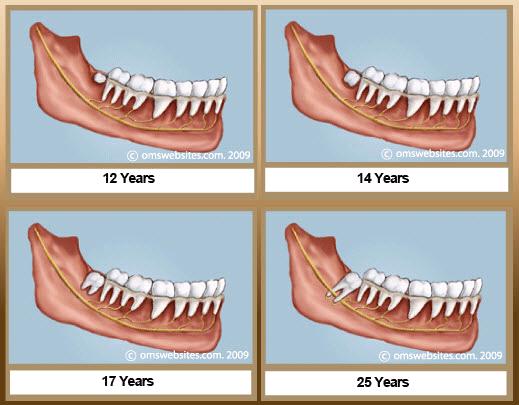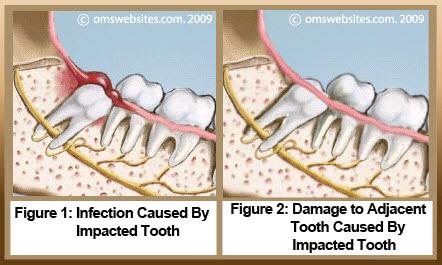What Is A Wisdom Tooth?
The last molars to erupt in the back of your mouth are commonly known as Wisdom Teeth (Mandibular Third Molar). They are called wisdom teeth because they usually begin coming in between the ages of 17 to 21 or older – the “coming of age” time period in a person’s life.

Normally an adult will have four wisdom teeth, but some adults may have more or less. Early humans had a rougher diet which caused wear on their teeth making it spatially possible for them to keep and use their wisdom teeth. However, with our current diet and the desire to have orthodontic teeth straightening, we produce a fuller arch in the jaw, creating less room for wisdom teeth to grow.
Why Do They Get Impacted?
A tooth becomes impacted because there is a lack of space in the dental arch, causing the tooth to grow on an angle towards the other molars and their roots or toward the jaw. This impaction can cause a lot of pain for the individual and can also lead to infection (See Figure 1). The wisdom tooth may also crowd or damage the adjacent molar and its roots (See Figure 2), or damage the jaw bone and its nerves. Also, when the wisdom tooth is growing toward adjacent teeth, it can trap plaque and debris making your teeth more vulnerable to decay.

Wisdom teeth will likely cause problems as the patient ages. Approximately 85% of wisdom teeth will need to be removed. We may recommend that your wisdom teeth are removed before they begin to cause problems in your mouth to avoid a more complicated procedure.
What Does Removing My Wisdom Teeth Require?
The ease of the wisdom teeth removal depends on the position of the tooth and root development. A wisdom tooth that has fully cut through the gum can be extracted much like any other tooth.
A wisdom tooth that is underneath the gums and pushed into the jawbone will require an incision into the gums and removal of the portion of bone that lies over the tooth. In this case, the tooth will be extracted in smaller portions to minimize the amount of bone that is removed.
Wisdom teeth can be removed using local anesthesia or some form of sedation. The anesthesia options will be discussed with you to determine what type of anesthesia is best for your needs.
What Does Recovery Involve?
After your wisdom teeth are removed you may experience some swelling and mild discomfort, which are normal symptoms and are part of the healing process.
Why are Teeth Removed?
Severe decay, infection or insufficient room are all reasons that your dentist may recommend removing or extracting teeth.
Impacted teeth that are partially erupted can cause a particular concern because bacteria can easily enter around the partially erupted tooth causing a possible extremely serious infection.
How are Teeth Removed?
During your initial visit, we will review your medical and dental history and take X-rays that will reveal the position of the tooth, its length and shape.
The area around where the extraction will take place will be anesthetized with a local anesthetic prior to removal.
What can I Expect After an Extraction?
In order to prevent infection following your extraction, it is very important to keep the area clean. For the first 24 hours following the surgery, you should avoid cleaning the teeth adjacent to the extraction site, refrain from smoking or rinsing your mouth vigorously.
You may experience a certain degree of pain or discomfort following an extraction. In certain cases, a pain killer may be recommended or prescribed.
You can also apply an ice pack to your face for 15 minutes at a time. You should avoid drinking hot liquids and not drink through a straw, and limit strenuous activity. The day after your extraction, you may be asked to gently rinse your mouth with warm salt water. If you experience severe or prolonged pain, bleeding, fever, or swelling, call us right away.
